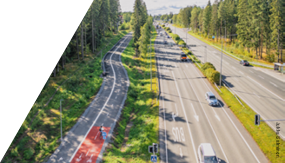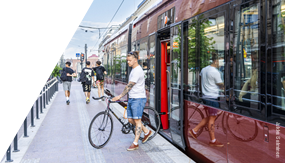Traffic emissions are a big challenge for municipalities in the mitigation of climate change, perhaps even the biggest. We have managed to decrease the emissions of other sectors, but the development of traffic emission amounts in Finnish cities has not been as rapid. We are working on this challenge in Tampere as well. The focus of the Tampere region’s Canemure subproject is particularly on combining modes of transport into sustainable travel chains.
Along the way, we have gained five insights on the matter that I wish to share as tips for everyone else.
1. Recognise the person behind the trip
The city’s task is to offer an environment where sustainable transport options are easy, fast and available to everyone. If sustainable transport is difficult or requires discipline or a heroic exploit, then it works as poorly as any other lifestyle change.
In addition to large investments from municipalities, transport guidance is needed: marketing, cooperation, communications, experiments, nudges and stories. Behind every transport choice is a person, as well as their daily life and holidays, needs and habits. The last one in particular is tricky: transport routines can sometimes be difficult to change, even if all rational reasons are in favour of sustainable transport.
The 250,000 residents of Tampere alone make a good two trips per day. Added together, these make up half a million choices every day! There is also an equal amount of daily opportunities for change.
In the Tampere region’s Canemure subproject, we have combined “hard” and “soft” actions: Electric bicycle trials have been offered alongside completed bicycle lanes, and the bicycles’ park-and-ride opportunity has been marketed. Campaigns and communications have been used to encourage the use of new public transport connections.
2. Even short trips matter
Mileage does not lie. The effectiveness of climate actions emerge where the distance driven with private cars accumulates and thus emissions are high. Attractive and competitive public transportation, smooth travel chains with first/last mile options and changes in fuels are the keys to change over longer distances.
However, short trips also matter. Of all the a couple-kilometre trips made in Tampere, over half are done by car. Over half!
This, of course, includes trips where sustainable transport is in no way reasonable. Reconciling various external demands and personal transport opportunities sometimes gets in the way of good will. However, I dare to claim that, among short car trips, there are those where change is possible, if only there is enough will and motivation.
There is an opportunity for sustainable travel chains in short trips. When a functional first/last mile solution is found for public transportation, a long car trip can turn into a sustainable travel chain.
3. Many objectives, many motivators
Sustainable transport will not be created just by decreasing the carbon load. However, the matter is made easy by the fact that, by increasing the share of public transport, walking and cycling, the sustainability of traffic improves in several ways.
In addition to climate goals, five objectives have been raised in Tampere’s sustainable urban transport plan: efficiency, safety, equality, environmental responsibility and activity. The list could be longer, but these already encompass a lot.
Diverse objectives can also be threads on which to pull when aiming to induce changes in residents’ transport. Well-being, the smooth running of daily life, a peer group’s transport culture and our budget all guide our choices. Including the choices of those for whom climate change is not a strong enough motivator to bring about change.
So, staring at greenhouse gas emissions alone is not a good idea. A car’s space requirement is the same regardless of fuel type, meaning that fuel alone will not solve the challenge. Short trips using your own muscles throughout the day are the best daily exercise that public health and the municipal economy will thank you for.
4. Tell a story, be an example
When the opportunities for sustainable transport are up to par, a gentle or more determined nudge is needed.
The effectiveness of transport guidance is increased through communication. One person who tries out replacing a car trip with a bicycle and train or an e-bike will not make a dent in an emissions graph, nor will five. It is important for us to highlight successful examples properly, share everyday stories from peers and encourage people to also talk about their experiences to others.
It is important for municipalities to lead by example. It is easier to encourage communities to change when your own actions are that of a pioneer.
5. Let’s take action together!
There is no point in reinventing the proverbial wheel in every city. Let’s share with each other which transport guidance actions have worked and which have not. Let’s copy good ideas. In other words, let’s keep in contact and consider the challenge of transport together!
Written by
Sanna Ovaska,
City of Tampere